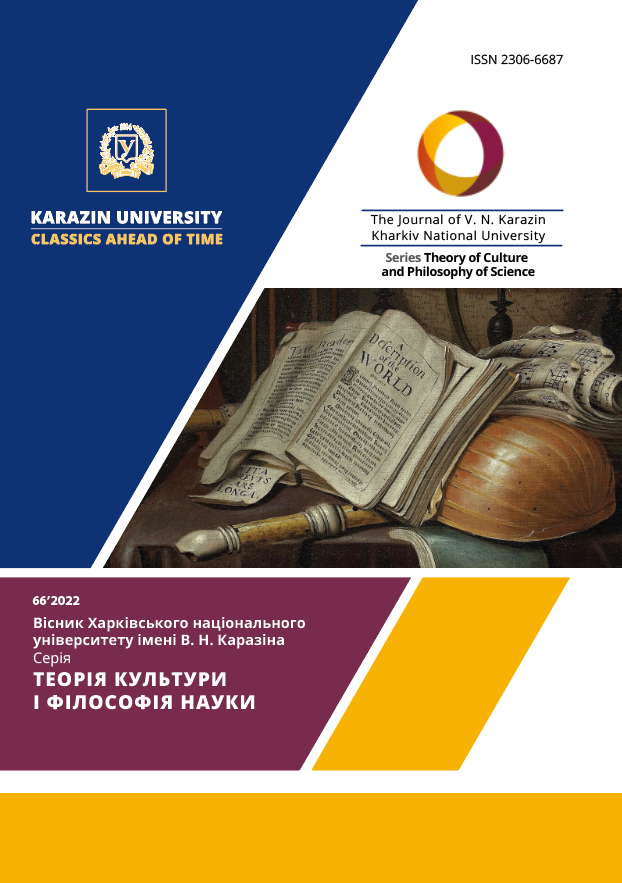INSTALLATION ART IN THEUKRAINIAN VISUAL CULTUREOF THE BEGINNING OF THE ХХІ CENTURY
Abstract
The article considers Ukrainian installation art. Artistic practices of installation represent one of the most interesting trends in world visual culture, which actively developed during the second half of the ХХ century and at the beginning of the ХХІ century. Installation is a relevant form of modern art, as it is focused on space and thus corresponds to an important guideline of modern culture — the spatial turn. It is proposed to consider the theory of installation by C. Bishop, according to which four types of installation can be distinguished: a phenomenological installation, de-subjectivizing installation, political installation, as well as a semiotic dream installation. According to Bishop's classification, the majority of Ukrainian art projects created in the installation technique are close to the semiotic dream installation. Ukrainian installation artists bring work with cultural meanings to the fore, rather than perceptual experience or anthropological experiments.
There are several central figures in the Ukrainian art scene who create installations and present various artistic strategies in their projects. Through installation art, artist M. Kadan addresses the understanding of the Soviet past and its presence in the current experience of Ukrainian culture. Art meets research here. The artist refers to the cultural layers of the past to make sense of them outside the ideologemes of Soviet propaganda and reveal the “paresis of things” to the audience.
The works by artist S. Petliuk develop the trend of media installation. Media technologies are actively used in the works of this trend. In his media installations, Petliuk deconstructs social and political ideologues, conducts “archaeological” explorations of modern urban space, addresses the question of comprehending war traumas, etc. Special attention is paid to the influence of the video installation on modern Ukrainian cinematography. The work of artist and film director I. Podolchak, who integrates the artistic principles of installation into his cinematographic works, is considered. An important trend of Ukrainian installation art is represented by the work of artist P. Makov. Makov's projects balance on the border between the culture of meaning and the culture of presence by filling his installation projects with deep cultural and political senses.
It is determined that Ukrainian installation art combines the traditions of Ukrainian visual culture and innovative artistic practices and is an important component of the world artistic culture of the beginning of the ХХІ century.
Downloads
References
Lozhkina A. Permanent Revolution: Art in Ukraine, the 20th to the Early 21th Century. Kyiv: ArtHuss, 2019. 544 p. (In Ukrainian).
Makov P. Utopia. Chronicles. 1992-2005. Kharkiv: Dukh I Litera, 2005. 144 p. (In Ukrainian).
Petluk S. Debris. 2011. URL: http://petlyuk.com/uk/works/debris/(In Ukrainian).
Bishop C. Installation Art. London: Tate Publishing, 2005. 144 p. (In English).
Deleuze G. Time-Image. Minneapolis: University of Minnesota Press, 2001. 344 p. (In English).
Deleuze G. Guattari F. Anti-Oedipus. Capitalism and Schizophrenia. Minneapolis: University of Minnesota Press, 2009. 432 p. (In English).
Foster H. Bad New Days. Art, Criticism, Emergency. London, New York: Verso, 2015. 208 p. (In English).
GreenbergC. Art and Culture. Critical essays. Boston: Beacon Press, 1971. 368 p. (In English).
Gumbrecht H. U. Production of Presence: What Meaning Cannot Convey. Stanford: Stanford University Press, 2004. 180 p. (In English).
Gumbrecht H. U. Meaning of Presence / Sententiae. Vol. 38 No. 1 (2019). P. 137-152. https://doi.org/10.22240/sent38.01.137 (In English).
Jameson F. Postmodernism, Or the Cultural Logic of Late Capitalism. Durham: Duke University Press,1991. 438 p. (In English).
Kosuth J. Art after Philosophy and After. Collected Writings 1966-1990. Cambridge, London: The MIT Press, 1991. 312 p. (In English).
Krauss R. “A Voyage on the North Sea”. Art in the Age of the Post-Medium Condition. London: Thames and Hudson, 2000. 63 p. (In English).
Krauss R., Foster H. Art Since 1900. Modernism, Antimodernism, Postmodernism. London: Thames and Hudson, 2016. 896 p. (In English)
Laclau E. Emancipation(s). New York; London: Verso, 2007. 128 p.
Lee P.M. Forgetting the Art World. Cambridge, London: The MIT Press, 2017. 244 p. (In English).
Nieuwenhuis M., Crouch D. (Ed.) The Question of Space. Interrogating the Spatial Turn between Disciplines. Ed. by London, New York: Rowman and Littlefield, 2017. – 201 p. https://doi.org/10.1080/2325548X.2019.1650556 (In English).
Smith T. Art to Come. Histories of Contemporary Art. Durham, London: Duke University Press, 2019. 440 p. https://doi.org/10.2307/j.ctv11smk7c (In English)
Warf B. Arias S. (Ed.) The Spatial Turn. Interdisciplinary Perspectives. London, New York: Routledge, 2009. 232 p. (In English).
Westgeest H. Video Art Theory. A Comparative Approach. Malden, Oxford: Wiley Blackwell, 2016. 211 p. (In English).




